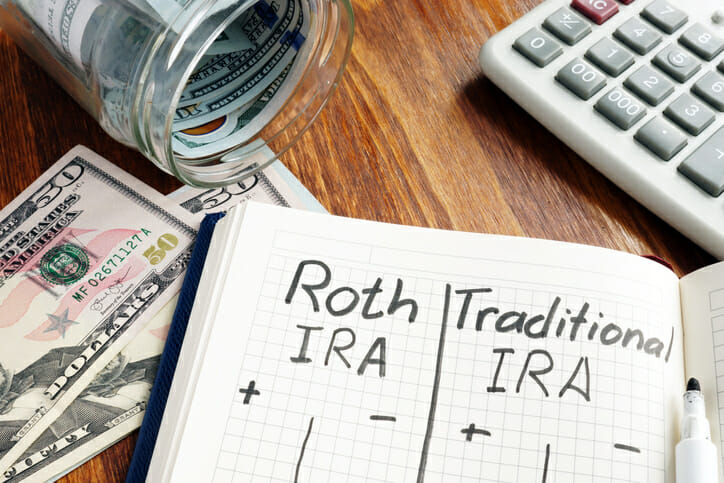The Roth IRA 5-year rule determines when withdrawals of earnings or converted funds can be taken without taxes or penalties. For earnings, the rule requires that at least five tax years have passed since the first contribution. For converted funds, the clock starts on each conversion, and early withdrawals may incur penalties if accessed too soon. Knowing the specifics of this rule can help avoid unexpected tax implications when planning retirement distributions.
The rules for Roth IRAs and retirement planning can be complex. A financial advisor can explain how they apply to your situation and help you create a plan.
What Is the Roth IRA 5-Year Rule?
The Roth IRA five-year rule is not a single guideline but a collection of rules designed to govern when funds in a Roth IRA can be withdrawn tax-free. These rules apply separately to earnings, converted funds and inherited IRAs, each with its own timeline and requirements. Let’s break down each of these rules to clarify how they work.
1. The 5-Year Rule for Earnings
The first five-year rule applies to the earnings on funds contributed to a Roth IRA. For a withdrawal of earnings to qualify as tax-free, the account must meet two requirements: it must have been open for at least five tax years, and the withdrawal must occur under a qualifying condition, such as the account holder reaching age 59 ½, becoming disabled or using the funds for a first-time home purchase.
The five-year period for contributions begins on January 1 of the tax year in which the first contribution is made, regardless of the exact date of the deposit. For example, if you made your first contribution in April 2025 for the 2024 tax year, the five-year clock started retroactively on Jan. 1, 2024. This timeline allows account holders to count the entire first tax year, even if the contribution was made later.
It’s important to note that this rule only applies to the earnings on your contributions. The contributions themselves can be withdrawn at any time without taxes or penalties, since they were made with after-tax dollars. However, improperly timing withdrawals of earnings can result in unexpected tax liabilities.
2. The 5-Year Rule for Roth Conversions

The five-year rule for Roth conversions ensures that funds converted from a traditional IRA to a Roth IRA are not used as a workaround for early withdrawals. Each conversion has its own separate five-year clock, which starts on January 1 of the year in which the conversion occurs. For example, if you converted funds in July 2025, the five-year clock for that specific conversion started on Jan. 1, 2025.
During this five-year period, any withdrawals of converted funds may incur a 10% early withdrawal penalty if you’re under age 59 ½. This is true even though the converted funds have already been taxed. However, this rule applies only to the converted amount, not to any earnings generated after the conversion.
It’s also worth noting that this rule is separate from the five-year rule for contributions and earnings. For account holders who make multiple conversions over time, careful record-keeping is necessary to track each conversion’s five-year timeline and avoid penalties on early withdrawals.
3. The 5-Year Rule for Inherited Roth IRAs
The five-year rule becomes more complex when it involves inherited Roth IRAs. If a beneficiary inherits a Roth IRA, they must determine whether the original account owner satisfied the five-year rule for earnings. If the original account was open for at least five tax years before the account holder’s death, any withdrawals of earnings will be tax-free for the beneficiary.
If the original account holder had not met the five-year holding period at the time of their death, their beneficiary won’t be permitted to withdraw the earnings tax-free until the five-year window has elapsed. The start of this five-year clock depends on whether the original account holder made their first contribution or completed a conversion. In cases where the clock has not yet run out, any distributions of earnings may be subject to taxes.
For beneficiaries who are required to deplete the account under the 10-year rule for inherited IRAs, the interplay between the five-year rule and the 10-year rule adds another layer of planning complexity. While beneficiaries can withdraw contributions tax-free at any time, they must carefully time earnings withdrawals to avoid tax implications.
Exceptions to the 10% Penalty
There are certain exceptions that allow you to avoid the 10% penalty even if you have not met the 5-year rule:
- Withdrawals of up to $10,000 for your first home purchase
- Instances of permanent and total disability, or if someone inherits your Roth IRA after your death
- The use of the funds to cover unreimbursed medical expenses if they exceed 7.5% of your adjusted gross income
- Payment of health insurance premiums if you are unemployed.
- Coverage of qualified higher education expenses for either you or a family member
- Placement of a tax levy by the IRS
- An agreement to accept equal periodic payments for five years or until you are 59 ½, whichever comes last
After you turn 59 ½, you can withdraw funds from the Roth IRA at any time if you’ve met the 5-year rule. If you have not met the 5-year rule, you can withdraw your contributions tax-free but not your earnings. You do not have to pay a penalty in this case.
How Financial Advisors Use the 5-Year Rule in Planning
Financial advisors often recommend starting Roth conversions early to begin the five-year clock as soon as possible. Each Roth IRA conversion has its own five-year period before the converted funds can be withdrawn penalty-free, regardless of age. By converting smaller amounts over several years, advisors create multiple conversion “buckets” that become available at different times. This approach offers clients flexibility in retirement, especially in years when other income sources are limited or when avoiding higher tax brackets is a priority.
Another strategy involves aligning Roth conversions with low-income years, such as after early retirement but before required minimum distributions (RMDs) begin. During this window, advisors may recommend that clients shift assets from traditional IRAs to Roth IRAs while paying tax at lower rates. This not only starts the five-year clock but also reduces future RMDs, which can lower taxable income later in retirement. By managing the timing and amount of each conversion, advisors help clients control their long-term tax exposure.
SmartAsset’s RMD Calculator can help you find out how much you’ll need to withdraw from your retirement accounts at RMD age.
Required Minimum Distribution (RMD) Calculator
Estimate your next RMD using your age, balance and expected returns.
RMD Amount for IRA(s)
RMD Amount for 401(k) #1
RMD Amount for 401(k) #2
About This Calculator
This calculator estimates RMDs by dividing the user's prior year's Dec. 31 account balance by the IRS Distribution Period based on their age. Users can enter their birth year, prior-year balances and an expected annual return to estimate the timing and amount of future RMDs.
For IRAs (excluding Roth IRAs), users may combine balances and take the total RMD from one or more accounts. For 401(k)s and similar workplace plans*, RMDs must be calculated and taken separately from each account, so balances should be entered individually.
*The IRS allows those with multiple 403(b) accounts to aggregate their balances and split their RMDs across these accounts.
Assumptions
This calculator assumes users have an RMD age of either 73 or 75. Users born between 1951 and 1959 are required to take their first RMD by April 1 of the year following their 73rd birthday. Users born in 1960 and later must take their first RMD by April 1 of the year following their 75th birthday.
This calculator uses the IRS Uniform Lifetime Table to estimate RMDs. This table generally applies to account owners age 73 or older whose spouse is either less than 10 years younger or not their sole primary beneficiary.
However, if a user's spouse is more than 10 years younger and is their sole primary beneficiary, the IRS Joint and Last Survivor Expectancy Table must be used instead. Likewise, if the user is the beneficiary of an inherited IRA or retirement account, RMDs must be calculated using the IRS Single Life Expectancy Table. In these cases, users will need to calculate their RMD manually or consult a finance professional.
For users already required to take an RMD for the current year, the calculator uses their account balance as of December 31 of the previous year to compute the RMD. For users who haven't yet reached RMD age, the calculator applies their expected annual rate of return to that same prior-year-end balance to project future balances, which are then used to estimate RMDs.
This RMD calculator uses the IRS Uniform Lifetime Table, but certain users may need to use a different IRS table depending on their beneficiary designation or marital status. It's the user's responsibility to confirm which table applies to their situation, and tables may be subject to change.
Actual results may vary based on individual circumstances, future account performance and changes in tax laws or IRS regulations. Estimates provided by this calculator do not guarantee future distribution amounts or account balances. Past performance is not indicative of future results.
SmartAsset.com does not provide legal, tax, accounting or financial advice (except for referring users to third-party advisers registered or chartered as fiduciaries ("Adviser(s)") with a regulatory body in the United States). Articles, opinions and tools are for general informational purposes only and are not intended to provide specific advice or recommendations for any individual. Users should consult their accountant, tax advisor or legal professional to address their particular situation.
For clients who may need access to Roth funds early, advisors carefully plan withdrawals to avoid penalties. If clients are under age 59½ and the 5-year rule for conversions has not been met, withdrawals of converted amounts could trigger a 10% penalty. Advisors may instead recommend drawing from Roth contributions (which are always tax- and penalty-free) or from other accounts to preserve Roth assets until they qualify for penalty-free access. Maintaining detailed records of contribution and conversion dates is critical in these situations.
Lastly, financial advisors use the 5-year rule to help sequence withdrawals across account types. In retirement income planning, advisors may prioritize taxable accounts first, followed by traditional IRAs and then Roth IRAs, which continue to grow tax-free. Once the five-year requirements are satisfied, Roth IRAs become a flexible source of tax-free income, useful for large one-time expenses or to manage taxable income in years with high Medicare premiums, capital gains or Social Security taxation. By coordinating the rule with broader planning goals, advisors can help clients maximize after-tax income over time.
General Examples: How the 5-Year Rule Can Affect You
The Roth IRA 5-year rule can play out differently depending on how and when you use your account. Here are some general examples to show its impact:
- Early saver: You open a Roth IRA in 2025 at age 30 and contribute $6,000. By 2030, you can withdraw earnings tax-free once you turn 59½, because the account has been open for at least five years. Until then, you could withdraw contributions tax-free but not the growth.
- Midlife conversion: In 2025, at age 50, you convert $40,000 from a traditional IRA to a Roth IRA. If you take money from that conversion before 2030, you may face a 10% penalty on the converted amount. Waiting until the five-year period ends, or until you turn 59½, avoids the penalty.
- Inherited account: You inherit a Roth IRA from a parent who first contributed in 2020 and passes away in 2026. Because the original account has been open more than five years, you can withdraw both contributions and earnings tax-free. However, you must still follow the 10-year rule for emptying the inherited account.
- Multiple conversions: You convert $25,000 in 2023 and another $25,000 in 2026. Each conversion has its own five-year clock. The 2023 conversion becomes penalty-free in 2028, while the 2026 conversion is locked until 2031.
Bottom Line

The Roth IRA five-year rule encompasses several distinct guidelines. The first applies to earnings, requiring that the account be open for five tax years before withdrawals are tax-free. The second governs conversions, where each converted amount has its own five-year timeline to avoid penalties. The third pertains to inherited Roth IRAs, ensuring beneficiaries adhere to the original account’s timeline or start their own five-year clock.
Tips for Retirement Planning
- As you can see, the Roth IRA five-year rule is complex. You may want to consult a financial advisor who specializes in retirement planning or tax strategy. Finding a financial advisor doesn’t have to be hard. SmartAsset’s free tool matches you with vetted financial advisors who serve your area, and you can have a free introductory call with your advisor matches to decide which one you feel is right for you. If you’re ready to find an advisor who can help you achieve your financial goals, get started now.
- Look at the SmartAsset retirement tax calculator to determine where you’d like to live during retirement to reduce your tax liability.
- How much money will you need to retire? Find out by using the SmartAsset retirement calculator.
Photo credit: ©iStock.com/SrdjanPav, ©iStock.com/designer491, ©iStock.com/cokada
